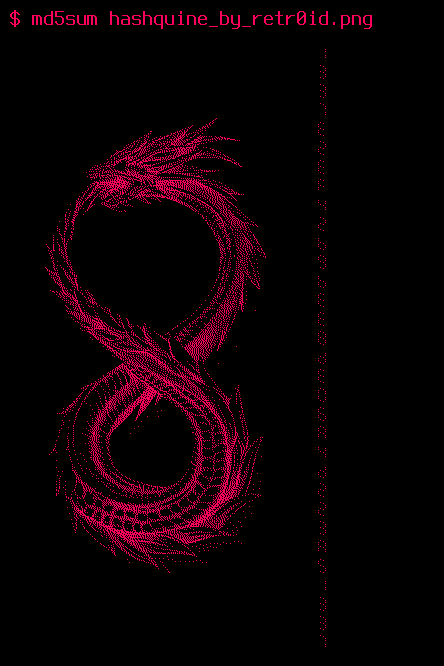This is very impressive. Someone managed to create an image whose MD5 hash (also known as MD5 sum) is in the image. Why is it impressive? Well, for one, hashes are computed based on the contents of the input, and even making a one bit change creates wildly different hashes. Let me illustrate this with an example:
$ echo -n 1234 | md5sum 81dc9bdb52d04dc20036dbd8313ed055 *- $ echo -n 1235 | md5sum 9996535e07258a7bbfd8b132435c5962 *-
1234 and 1235 differs by just 1 bit. In binary:
1234 is 00110001 00110010 00110011 00110100 1235 is 00110001 00110010 00110011 00110101
and yet the MD5 hash is totally different. Imagine if you’re trying to create a text document with this content:
The MD5 sum of this is: 12345678901234567890123456789012
Obviously the MD5 hash is not going to be 12345678901234567890123456789012.
It computes to b8aca742ffc52d6bea85fd87a92d3ede.
So you tweak the contents to this:
The MD5 sum of this is: b8aca742ffc52d6bea85fd87a92d3ede
Now the MD5 sum becomes 878da8ba44a3938fdce6da2191f221a1.
The minute you attempt to tweak the contents, the MD5 hash changes.
So it is possible to engineer a text such that the MD5 hash is contained in the text? The answer is probably yes. But you will have to test 2^128 combinations to find it.
Which brings us to the image. Creating an image like this is difficult, due to the encoding and checksums that a valid PNG image needs to have. Yes it’s not the first image-based hash quine (or file that show their own hash), but what makes this even more impressive is the deliberate choice of choosing 1337 to appear at the front and back of the MD5 sum.
Kudos to the author for this achievement.
The image in this post displays its own MD5 hash. You can download and hash it yourself, and it should still match – 1337e2ef42b9bee8de06a4d223a51337 I think this is the first PNG/MD5 hashquine.
Source: Retr0id
